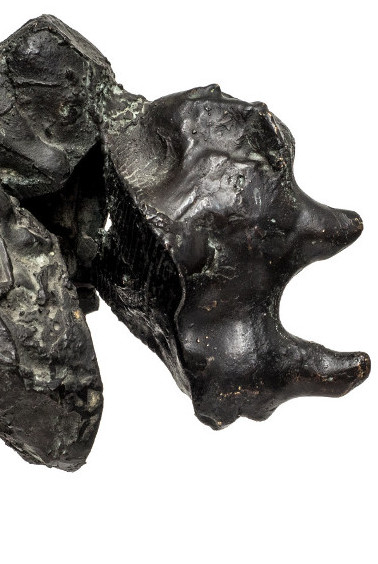|
"Delahaye"
by Manfred de la Motte
Modern art's emergence continues. Although a kind of contemporary style has established itself in the consciousness of a large-scale public in terms of sculpture and painting, this concept of style, which offers security, is constantly being changed by the work of artists who do not rely on the newly created tradition, but - looking forward - work towards a future which mirrors the present. One of them is Jacques Charles Delahaye, who has only been seen in a few exhibitions in Germany, although he can be found in every reference book on modern sculpture. His works do not shock and are not the result of a revolutionary "trick".
The title suggests it is human and animal, thus representational and possibly depicting a scene (a battle between horse riders - but only based on the title!). Almost all the animal sculptures from this century, from Brancusi to Marini, were animal emblems, reductions to the essential, abstractions of the many, the general, to the unique, the authoritative. This claim of presenting the animal as such is lost in Delahaye's work. And all of his titles are an excuse: he does not sculpt representationally, but only manifests himself. His famous "Cat" from 1952, which was shown at Dokumenta II, already shows his disinterest in anatomy, image or symmetrical body shape. "The Cat" is a sequence of structures, formed in various ways from bronze, a sequence of numerous details, which, as a sum, gives rise to that skittish movement that justifies the title.
After years of sculpture being determined by themes or topics, something new appears, an independence from the programme and prefabricated design; even continuous development within the work itself is omitted. The less an artist is tied to tradition, programme and style, the greater the need to activate personal commitment and action in a relevant way. Delahaye's sculptures are no longer solid form, neither solid in the sense of a block-like volume, where sculptural force grows into the space from the inside out, nor are they actually form, if one understands it as a sculptural event that is defined by the surrounding space, or conversely, defines the space like a kind of exclamation mark. Nothing can be identified as fixed about Delahaye, but neither can anything be identified as free or imprecise - neither Arp nor Calder were the inspiration. The finished article, perfection and - if one can say it bluntly - the artwork is still missing: the problem and its brilliant solution. But what is it, after all these negative distinctions?
His activities are proof of action, coagulated into sculptural form, solidified into sculpted events. Delahaye's sculptures are multi-layered, discontinuous and ambiguous. They bear witness to Delahaye's approach to the world as an artist, and provide answers to everything that shapes him. A shell-like object surrounds a semblance of a core, grows together like buds or leaves and is prevented from unrestrained proliferation; the material is sometimes "wrinkled" by his hands (Eduard Trier in his book "Figure and Space") and deformed beyond recognition. Rarely has so much been demanded of bronze as a material. His sculptures are an individual and unique process; a process more than a static, inward rest. In this way, the series of "Samurais" were created, full of tension and warlike intensity down to the individual muscles and curves of form, ready for an act of violence, an outburst. But they are reproduced in a moment of uncanny calm, capable of anything and so explosive that it is surprising that these sculptures - which they are nevertheless - need a pedestal. Everything that used to be called mass and volume in sculpture is dynamic for Delahaye, pointed in a certain direction. And conversely, a balanced calmness is formed from diverse and also counter-rotating dynamics, which results in the impression of a voluminous mass. The movement is total and so consistent that it can change into its opposite as a consequence. Delahaye is highly expressive: not as a "style", but as a gesture, as an attitude.
Through Delahaye, the work of art has become a process that the viewer must trace. The viewers' intense attention also has a formative effect, the sculptures offer hints for dealing with the complex sculptural processes, for following the shell-like structure when it circles a centre or counts as intrinsic value, or for identifying the incisions, runes and lines and examining them in terms of their separating or connecting function. Delahaye's sculptures are scores for attentive viewers who can read sculpture out of them as an experience and thus participate in the process of contemporary art.
|
